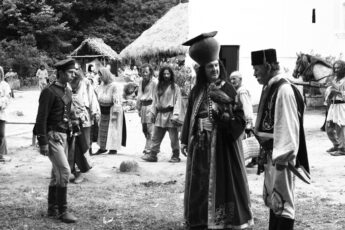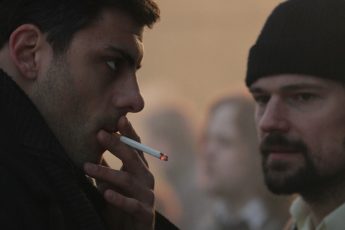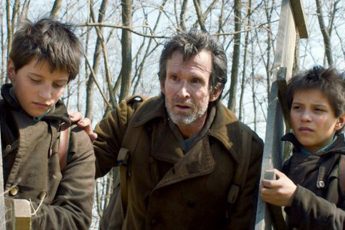Crime and Media
Marcin Koszałka’s The Lust Killer (Zabójcę z lubieżności, 2013)
Vol. 38 (February 2014) by Colette de Castro
The Lust Killer is the latest feature from prolific documentary filmmaker Marcin Koszałka. This distinctly clever documentary, fascinating and disturbing in equal measure, is based around the history of a Polish serial killer and those who surrounded him during his trial.
Although the film focuses on one person in particular, its title doesn’t lead us clearly to him. The English translation may be confusing, because although this film is about a Polish serial murderer, there was once an American killer named Jerry Brudos who was commonly known as “The Lust Killer”. Another Polish serial killer, who committed many more murders than the one studied here, lived from 1927 – 1977. He was Zdzisław Marchwicki, otherwise known as the “Polish Vampire”. This film however, inquires into the case of Joachim Knychała, who came to be known in Poland as the “Vampire from Bytom”. The nicknaming of such assassins could seem strange in the face of such horror, but it reflects a general fascination surrounding historic killers – perhaps even a certain glorification –; The Lust Killer concentrates on this impulse.
Between 1975 and 1985 Joachim Knychała killed five women in the upper Silician area of Poland. Some people called him the Polish Ted Bundy because of his unusual looks. The slight ambiguity in the title can be explained by the films contents, as it doesn’t concentrate on the criminal himself, but rather on a journalist who wrote about and worked with Knychała. The film thereby becomes an essay on the interest which such a character can hold. In the opening scenes we are introduced to a retired police officer and his wife: they are arguing about the way he makes a cake – she is nagging him about the amount of butter he’s using – and we understand straight away that this film is not predictably on the subject. The policeman later talks about his experiences of finding the first dead woman, although he is unable to explain how her entrails were caught up in a wire fence, which prevented him from pulling her into the open. These are details his wife fills in for the viewer – tutting about his still not being able to explain details “after all these years”. A knock at the door and we are introduced to the main character of the film, the journalist who worked with Knychała, writing about him and encouraging him to write about the murders. The journalist is an unusual character – wearing a brightly colored beanie and a shirt covered in tigers – we don’t realize at first that like his friend the police officer, he too is an old man.
The filmmaker’s not-so-subtle approach to the main obsession in the film is to follow the journalist through sex clubs of the most nauseating kind. The journalist is then exposed at his most vulnerable, first when he is shown half-naked, then when he buys a lap dance and goes into a kind of catatonic trance – glassy-eyed and groaning as a woman in a cat mask gyrates over him. He confesses his fear of growing old to the camera. The crux of the film is soon presented: what drove Knychała was sexual attraction to corpses, otherwise known as necrophilia. The journalist’s eventual confession of his secret admiration for Knychała’s having “broken through the boundaries and social norms” is all the more startling when placed in such a context. One can only marvel at Marcin Koszałka’s filmmaking revealing so many secret details.
The filmmaker weaves a complicated net around the journalist and his fear of old age, the viewer and our own morbid fascination with the serial killer. He cleverly draws a parallel between necrophilia and pornography – is the journalist – masturbating to images (not live) of young women having violent sex, and by extension the viewer – watching him watching them, really that much less of a criminal than Knychała? Being unable to find a willing sexual partner is often cited as the main cause of that particular fetish, but male jealousy over the female power of creation could also be considered in this context. The necrophiliac reverses gender roles by killing the woman and inseminating her once she can no longer be fertilized, thus claiming for his own the power of creation. But these are dark waters and the filmmaker just touches the surface of them with a few well-placed images and scenes.
The journalist tells the cameraman about the glory he experienced following his link with the killer, during which he convinced him to write a diary and to publish his memoirs: he proudly asserts that he was recognized in the street, adulated, congratulated. “Thanks to you, I am in this film, and perhaps thanks to you, I will come back. I am simply using you,” he states to the camera. He speaks in half-regretful tones about Joachim Knychała, saying: “I used him and sold him; he regretted everything. They hanged him.”
These daunting confessions finally culminate in the highly-disturbing final scene in which our journalist reads from the diaries of Knychała, an extract in which he describes the rape of one of his victims and his subsequent prayers for her death when he finds out she didn’t die immediately. This film is certainly not for the fainthearted, but does offer a fascinating glimpse into the psyche of the journalist and thereby into our own.




Leave a Comment